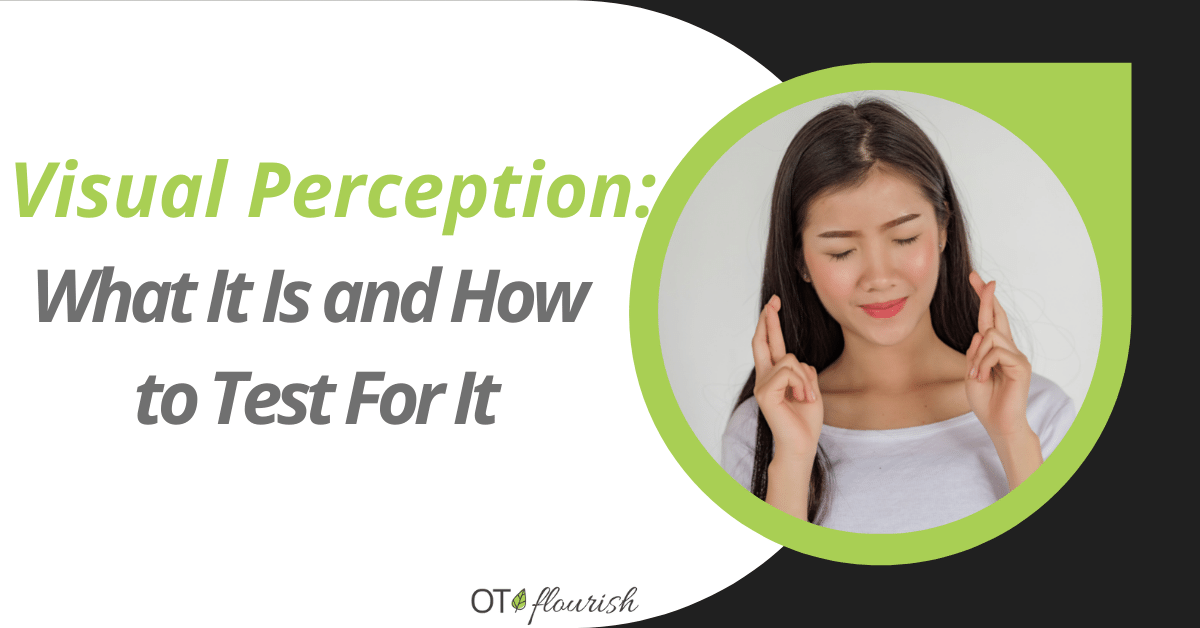Visual Perception: What It Is and How to Test For It

When the word “perception” comes up in healthcare conversation, intuitively you should know that causes for concern go beyond just the structure of the eyeball. Visual information is taken from the surrounding environment and fed through the eyeballs. If visual disruptions were a matter of near or far sightedness (i.e. visual acuity), for example, then visual limitations lie within the eyeballs themselves. If the eyes are anatomically healthy while the brain is having trouble processing and interpreting visual information, we are now seeing the hairy mess of visual perception problems.
Visual Perception Defined:
Visual perception is different from problems involving sight or sharpness of vision. Difficulties with visual processing affect how visual information is interpreted, or processed by the brain.
So basically, it is not what the eyes see, but how the brain reads what your eyes are seeing.
Visual perception is an umbrella term for a handful of different visual processing and visual perceptual skills including:
Figure ground:
- locating a single shape or object propped against a busy background (i.e. the classic “Where’s Waldo” books).
Form discrimination:
- noticing similarities and differences between objects regarding size, shape, color, position and so on.
Spatial relations:
- accurately judging the position and space between objects (i.e. judging how far away one’s own body is from another person).
Visual closure:
- identifying and recognizing an object without seeing the entire object (i.e. recognizing one word quickly without analyzing every single letter in all instances).
Form constancy:
- Recognizing objects or symbols even when they are shrunk, enlarged, or turned/positioned differently (i.e. reading and recognizing a word that’s upside down).
Object recognition:
- Simply recognizing objects, symbols, pictures, or words for what they are (i.e. the term for the disorder of object recognition is called visual agnosia).
Whole/part relationships:
- perceiving the relationship between pieces that make a whole (i.e. puzzles, words, body parts, etc.).
Visual memory:
- remembering forms and sequences so as to quickly recognize it again at a later time (i.e. recalling letters and letter sequences that form words in order to not have to relearn the same words over and over again).
What Conditions Cause Visual Perception Disorders?
Visual perceptual disorders in adults can result in limitations of one or several of the mentioned skill sets. Since the brain is responsible for overall perception and processing, the cause is generally neurological damage from injury or illness.
Examples include:
- stroke
- brain injury (traumatic, anoxic, etc)
- encephalopathy
- brain tumor
- multiple sclerosis
- dementia
Occupational therapists who work with older adults will eventually interact with these conditions. Thus, it’s crucial for OTs to readily identify potential visual perceptual problems that can interfere with their patients’ participation inside and outside of regular therapy services.
How Can an OT Assess for Visual Perception Disorders?
One of the most common visual perceptual tests used by occupational therapists is the Motor Free Visual Perception Test (MVPT -4), developed by Colarusso and Hammill (2015), and is the only assessment available to test motor-free perceptual issues across the entire span of life (4-80+ years). Several clinicians, including occupational therapists, use the MVPT-4 in order to confirm or rule out visual perceptual limitations as well as to guide intervention strategies.
The MVPT-4 is not necessarily a taxing assessment regarding administration time because it only takes 20-25 minutes to fill out. Unfortunately, it’s not a free assessment so some funding justification may be needed in certain clinical settings.
Below is a brief example of administration of the MVPT – 4
How Do I Advocate For My Adult Patients With Visual Perception Problems?
If your clinical setting consistently evaluates adults with brain-related conditions, but visual perceptual testing goes unacknowledged, then it is time for an occupational therapist to step in. A few examples include:
- Conduct your own research: As a therapist, you are usually on your own for obtaining education. Dive into the research and become an expert in visual perception in OT. If you do not have access to research, use open journals like the Open Journal of Occupational Therapy or join membership organizations, like the OT Flourish Membership, that rely on research and best practice integrating the client’s perspective and OT clinical experience.
 to level up your practice! Join the OT Flourish Membership today!" width="1080" height="720" />
to level up your practice! Join the OT Flourish Membership today!" width="1080" height="720" />
- Volunteer to provide in-service training: Talk to your team leaders and schedule a lunch hour to provide an in-service training for you and your colleagues. Your coworkers may not even realize how big of a problem it is, especially if your department is filled with relatively new therapists.
- Note patient cases where visual perception does not get addressed: Keep track of your patients who have diagnosed brain-related disorders and who have not been tested for visual perceptual challenges. Reflect on how their therapy sessions could have been more effective with a visual perceptual test and what observable struggles they’ve experienced: trouble with reading instructions, unexplained issues with fine motor tasks such as puzzles, picture books, charts, etc.
- Advocate for funding With your research and patient cases in mind, have an open and honest discussion with your team leaders and administration in order to access funds for the MVPT-4 test to be used in your setting.
Visual perceptual disorders are more common in older adults than you think and are easy to miss unless you have a trained eye. Start your research today in order to better evaluate and to better tailor therapy services for your patients.
 to level up your practice! Join the OT Flourish Membership today!" width="1080" height="100" />
to level up your practice! Join the OT Flourish Membership today!" width="1080" height="100" />
Guest Blog Post by Meredith D. Chandler, OTR/L, Freelance Content Writer



 to level up your practice! Join the OT Flourish Membership today!" width="1080" height="720" />
to level up your practice! Join the OT Flourish Membership today!" width="1080" height="720" /> to level up your practice! Join the OT Flourish Membership today!" width="1080" height="100" />
to level up your practice! Join the OT Flourish Membership today!" width="1080" height="100" />